


בעלת תואר מוסמך במנהיגות לשמירת טבע מאוניברסיטת קיימברידג', ותואר מוסמך בלימודי מדבר מאוניברסיטת בן גוריון.
פורסם ב’וואלה’ בתאריך: 31/10/2020, עדכונים ותוספות ב-7/11/2020 וב-9/11/2020
מה בין הקורונה ליחסנו לטבע? אם תשאלו מדענים, מתברר שהקשר הדוק. הפאנל הבין-ממשלתי האמון על המגוון הביולוגי ושירותי המערכת האקולוגית מטעם האו”ם (IPBES) פרסם בחודש אוקטובר 2020 דוח ראשון בנושא. 22 המדענים שערכו את הדוח עמדו על הקשר בין שמירה על הטבע להתפרצות מחלות זאוטוניות, מחלות שמקורן בבעלי חיים שעשויות לעבור לבני אדם, כמו נגיף הקורונה.
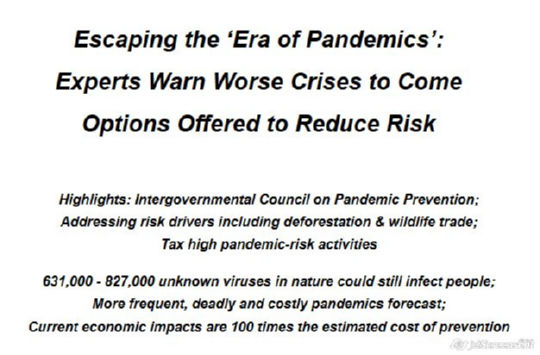
מומחי בריאות וסביבה סיכמו בדוח ממצאים מדעיים, וחשפו בדוח נדבך נוסף בהתפרצויות המחלות. הסיבות העיקריות: שינוי בשימושי קרקע – משטחים טבעיים לחקלאות או פיתוח, שינויי אקלים, אובדן המגוון הביולוגי, סחר וצריכה ישירה של חיות בר וחיות משק וכן לחץ אנושי גובר הקשור לעלייה באוכלוסיית בני האדם על כדור הארץ. במאי השנה כבר הוכח כי הסיבה להתפרצות של מעל 70% מהמחלות הזואונוטיות הוא ניצול יתר של הטבע.
מתוך 1.7 מיליון וירוסים שמעריכים שקיימים בטבע ועדיין לא נתגלו, מעריכים המדענים כי 850 אלף וירוסים עלולים להדביק בני אדם, ושכחמישה וירוסים חדשים צפויים לצוץ כל שנה ומהם לפחות אחד בעל פוטנציאל להפוך למגיפה.

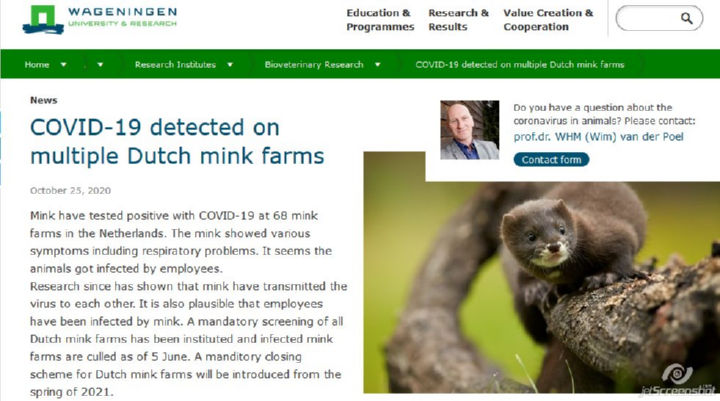
“עסקים כרגיל הם לא אופציה, צריך שינוי משמעותי”, אומר דיוויד דאסזק, אחד המדענים המובילים בכתיבת הדוח. “השקעה במניעת מגיפות במקום להסתפק בתגובה להתפרצות מגיפות, ושיקום כלכלי ירוק מקורונה, ישתלמו אפילו בטווח הקרוב”.
הדוח מציע מגוון פתרונות, בנוסף להמלצה העיקרית של צמצום צריכה וסחר במזון מן החי. המלצות נוספות הן צמצום של הרס שטחים פתוחים וכריתת יערות, הגדלת המס על מוצרים שייצורם מגביר את הסיכון להתפרצות מגיפות, הכנסת מנגנונים להערכה של השלכות פיתוח בשטחים פתוחים על הסיכון להתפרצות מחלות ועוד. לפי IPBES, שמירה על הטבע ועל שטחים טבעיים מחוברים ומתפקדים, שמסוגלים להכיל מספר רב של מיני בעלי חיים וצמחים, תגדיל את החוסן הטבעי של המערכות האקולוגיות.
גם מנהיגי העולם מתחילים להכיר בחשיבות הנושא. בסוף ספטמבר התכנסה פסגת מנהיגים של האו”ם בנושא שמירה על הטבע ומנהיגי העולם, החל מנציבת האיחוד האירופאי ועד המלך עבדאללה מירדן ונשיא המדינה ראובן ריבלין. אחד אחד עלו לדבר על המחויבות שלהם לשמירת הטבע והיציאה לא רק ממשבר הקורונה – אלא גם ממשבר האקלים והמשבר האקולוגי שהעולם נמצא בו.
ישראל חתמה על הצהרת המנהיגים המפרטת שורה של פעולות כלל-ממשלתיות הדרושות לשמירה על הטבע, ומניעת הסיכון להפצת מחלות נוספות. ריבלין הצהיר בנאומו לאומות העולם כי ישראל מחויבת לקדם אנרגיה נקייה ושיקום שטחים פתוחים, וקרא לפעול עכשיו על מנת להגן על הטבע והמגוון הביולוגי.אם בוחנים את המרחק בין הצהרות המנהיגים על חשיבות השמירה על הטבע והמעשים בפועל – הפער עצום. עם זאת, האיחוד האירופי לא מתמהמה וכבר מציב עובדות בשטח – ועדת שרי הסביבה של האיחוד התכנסה בשבוע שעבר ועברה מדיבורים והצהרות למעשים, במטרה להוות דוגמה.
לפי שרת הסביבה הגרמנית, סבניה שולץ, הטבע והמגוון הבילוגי הם “ביטוח החיים שלנו” ומספקים אוויר נקי, מים נקיים, אוכל, עבודות ופרנסה. לדבריה, עם הרס הטבע גובר הסיכון להתפרצות מחלות חדשות ומגיפות. לכן ועדת השרים החליטה לאשר את התכנית האסטרטגית האירופית עד 2030 לשמירה על הטבע והמגוון הביולוגי.
ועדת השרים האירופית קבעה כי כ-30% מהסיוע הכספי להתאוששות מהקורונה, שסומנו עבור פעולות לשינויי אקלים, יוקצו לשמירה על הטבע, עמידה ביעדים מחייבים לשיקום אקולוגי של שטחים פתוחים וקידום פתרונות מבוססי טבע על מנת להילחם בשינויי אקלים. בין היתר, מדובר בפעולות לשמירה על יערות, ביצות, אזורי הצפה של נחלים. ועדת שרי האוצר האירופאים צפויה להתכנס בשבוע הקרוב על מנת להחליט על ההקצאות התקציביות הסופיות.
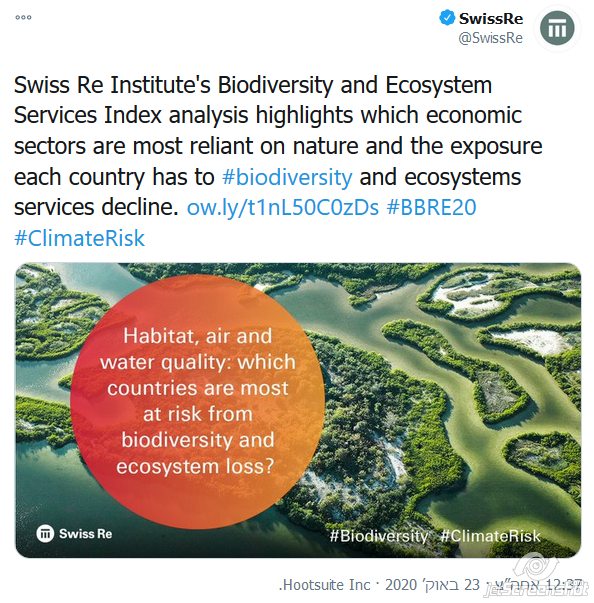
מכון SwissRE מתחום הביטוח פרסם החודש דירוג ובו כימת סיכונים בתחום הטבע. בדוח נמצא כי חמישית ממדינות העולם נמצאות בסיכון של קריסת מערכות אקולוגיות טבעיות. ישראל מככבת באחד המדדים, וזכתה להיכלל ברשימת 20 המדינות שמצב המגוון הביולוגי ושירותי המערכת האקולוגית שלהן הוא השברירי ביותר בעולם, מקום שני אחרי מלטה ורק קצת יותר טוב מבחריין.
בישראל, יש יותר מ-25% של שטחים מוגנים ביבשה. עם זאת, חלק גדול נמצא בנגב ובשטחי אש. שטח המים הטריטוריאליים המוגן בישראל הוא רק 2.5%, ולא השיג עדיין את השאיפות שישראל הציבה במסגרת יעדי הפיתוח הבר קיימא באו”ם – 8.5% לפחות בים ו-30% ביבשה. מינים רבים בישראל נמצאים בסכנת הכחדה מקומית ועולמית.
מהמשרד להגנת הסביבה נמסר כי המשרד מגבש בימים אלה הצעת מחליטים לשמירה על המגוון הביולוגי. ההצעה כוללת רכיבים של חיזוק המערכות האקולוגיות הייחודיות לישראל, שמירה על החי והצומח, צמצום הפגיעה בשטחים הפתוחים, הטמעת שיקולי מגוון ביולוגי במגזר העסקי, מניעת חדירה של מינים פולשים וכן רכיב של הכנת תכנית פעולה לאומית למגוון הביולוגי. לפי המשרד, הצעת ההחלטה תובא בחודשים הקרובים לאישור הממשלה.
בעשור האחרון הוכרזו כ-3% משטח המדינה כשטחים מוגנים: כ-103 שמורות טבע וגנים לאומיים בשטח יבשתי של 634 אלף דונם. בשנת 2019 הוכרזו 20 שמורות טבע וגנים לאומיים חדשים, בהן שמורת טבע ימית גדולה, ראש הנקרה-אכזיב, בהיקף של 100 אלף דונם. עם זאת, בשטחים מוגנים אלו אין ייצוג הולם של בתי גידול ההופכים לנדירים בישראל – כגון חולות מישור החוף, בריכות החורף וקרקעות הלס בנגב.
התכנית הלאומית למגוון ביולוגי צפויה לכלול דגש מיוחד על הגנה ושיקום אקולוגי של כתשעה סוגים של בתי גידול שאינם מיוצגים כראוי בשמורות הטבע הקיימות. מהמשרד להגנת הסביבה נמסר כי ללא שיקום של חלק מבתי גידול אלו, לא ניתן יהיה להגיע ליעד שישראל מחוייבת אליה לפי אמנת המגוון הביולוגי של האו”ם.
אריאל ברונר מבירדלייף אינטרנשיונל מדגיש בשיחה עם וואלה! NEWS כי לישראל תפקיד מפתח על אף גודלה הקטן, שכן היא בנקודה אסטרטגית בציר הנדידה של ציפורים ונקודת מפגש בין שלוש יבשות. לכן, הוא אומר ממקום מושבו בבריסל, המדינה נושאת באחריות גדולה – אך גם בהזדמנות נדירה. “לשיקום אקולוגי של שטחים פתוחים בישראל, כגון בתי גידול לחים ושטחים חקלאיים, תהיה השפעה חוצת גבולות על שמירת הטבע – מסיביר הארקטית עד לדרום אפריקה”.
השטחים הפתוחים והמוגנים בישראל בעיקר באזור מרכז הארץ אינם מחוברים כראוי, ולכן התווך החקלאי הוא קריטי ביותר על מנת ליצור קישוריות.
ממשרד החקלאות והכפר נמסר בתגובה כי המשרד “מברך על חתימת הצהרת המנהיגים בפסגת האו”ם וגאה בכך שישראל עתידה לקחת חלק בקידום תכנית לאומית למגוון ביולוגי. המשרד יעזור ויפעל ככל שיידרש בנושא”.
עוד הוסיפו במשרד כי הם “פועלים לקידום תכניות למסדרונות אקולוגיים במטרה להגן על השטחים הפתוחים לצד הבטחת העיבוד החקלאי בשטחים החקלאיים. בנוסף, המשרד הניע מהלך אסטרטגי לגיבוש תכנית מדיניות משרדית ארוכת טווח לחקלאות סביבתית, המפחיתה את ההשלכות השליליות על הסביבה, מעצימה את אלה החיוביות, בד בבד עם שמירה על חקלאות מקומית והבטחת רווחיות”.
השרה להגנת הסביבה גילה גמליאל מסרה לוואלה! NEWS כי היא הגדירה את נושא המגוון הביולוגי כנושא ליבה של המשרד. “אני פועלת במספר ערוצים לטובת קידום הנושא, בין השאר – רגולציה, מדיניות ותקצוב”, הבהירה השרה.
“בנוסף, כללתי את הנושאים של שיקום נחלים וטבע עירוני בתכנית ההתאוששות ממשבר הקורונה”, הוסיפה. “אישרתי הוראת שעה למניעת ציד של התור המצוי והשליו הנודד הנמצאים בסכנת הכחדה, תקנות למניעת סחר בפרוות בעל חיים, ותזכיר חוק לתיקון חוק להגנת חיות הבר – למניעת הרעלות חיות בר”.
השרה הדגישה גם את הצורך שישראל תוביל בדוגמה אישית בנושא גם מבחינת יחסי חוץ: “חשוב מאוד שמדינת ישראל תתחייב באופן ברור גם בזירה הבין-לאומית לקפיצת מדרגה בפעילותה לשמירה על המגוון הביולוגי, ולכן אני מתכוונת להביא לממשלה החלטה המאגדת את הפעולות הדחופות הדרושות לשמירה על המגוון הביולוגי בישראל תוך התאמתה לאמנת המגוון הביולוגי” .
עם זאת, למרות מחויבות המשרד ודחיפות הנושא שמתחדדת לאור משבר הקורונה, לא ברור האם החלטת הממשלה בנושא המגוון הביולוגי, כולל נושא שיקום המערכות האקולוגיות, מתוכננת להיכלל בתקציב המדינה הקרוב.
בחברה להגנת הטבע מברכים על שלל הפעולות שהשרה עשתה לאחרונה, כולל קידום נושא מניעת הרעלות של חיות הבר, אך מביעים זהירות אופטימית.
אלון רוטשילד, מנהל תחום המגוון הביולוגי בחברה להגנת הטבע, אמר כי “צריך לראות כמה כסף בפועל מתוך תקציב המשרד ותקציבי הממשלה מנויד עכשיו ובשנים הקרובות לטובת שמירת המגוון הביולוגי, אילו פעולות חקיקה מערכתיות המשרד יוזם ומוביל, למשל בתחום המינים הפולשים, והאם בפועל יוכרזו מינים בסכנת הכחדה כמינים מוגנים, כגון דקר הסלעים”. הוא הבהיר כי “המבחן שלנו, של הטבע ושל הציבור הוא מבחן התוצאה”.
לפי מדענים מובילים, אם נמשיך להרוס את הטבע ויערות הגשם, נחיה בעידן של מגיפות שלא ייגמר עם החיסון לקורונה. צריך לפעול עכשיו, וכמה שיותר מהר כדי לצמצם את צריכת האנושות של משאבים מהטבע, כולל מזון מן החי ולהשקיע במניעת מגיפות כיוון שזה יעלה פחות מלטפל בכל התפרצות בנפרד ולעשות תכניות כוללניות חוצות מגזרים ומשרדי ממשלה על מנת להגן על הטבע שנשאר וכן לשקם שטחים שהרסנו בעבר.
מקור: ‘וואלה!’, נועה שטיינר
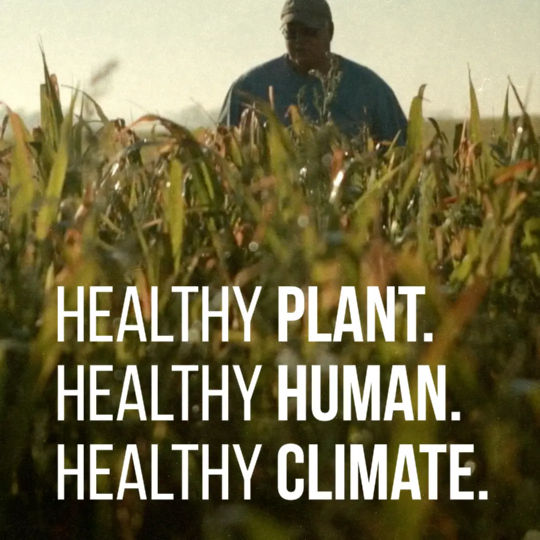
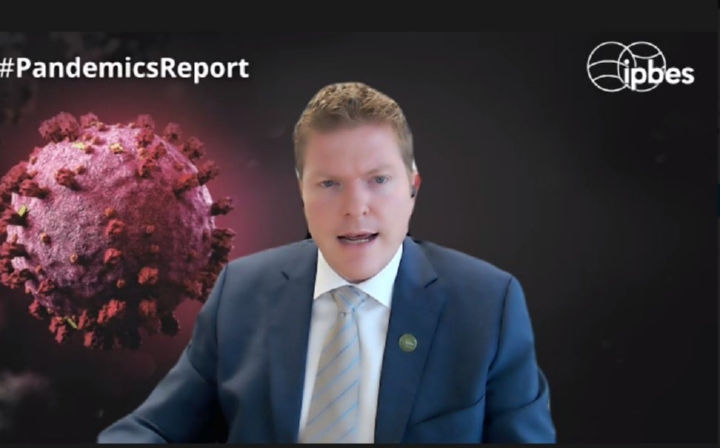
Future pandemics will emerge more often, spread more rapidly, do more damage to the world economy and kill more people than COVID-19 unless there is a transformative change in the global approach to dealing with infectious diseases, warns a major new report on biodiversity and pandemics by 22 leading experts from around the world.
Convened by the Intergovernmental Science-Policy Platform on Biodiversity and Ecosystem Services (IPBES) for an urgent virtual workshop about the links between degradation of nature and increasing pandemic risks, the experts agree that escaping the era of pandemics is possible, but that this will require a seismic shift in approach from reaction to prevention.
COVID-19 is at least the sixth global health pandemic since the Great Influenza Pandemic of 1918, and although it has its origins in microbes carried by animals, like all pandemics its emergence has been entirely driven by human activities, says the report released on Thursday. It is estimated that another 1.7 million currently ‘undiscovered’ viruses exist in mammals and birds – of which up to 827,000 could have the ability to infect people.
“There is no great mystery about the cause of the COVID-19 pandemic – or of any modern pandemic”, said Dr. Peter Daszak, President of EcoHealth Alliance and Chair of the IPBES workshop. “The same human activities that drive climate change and biodiversity loss also drive pandemic risk through their impacts on our environment. Changes in the way we use land; the expansion and intensification of agriculture; and unsustainable trade, production and consumption disrupt nature and increase contact between wildlife, livestock, pathogens and people. This is the path to pandemics.”
Pandemic risk can be significantly lowered by reducing the human activities that drive the loss of biodiversity, by greater conservation of protected areas, and through measures that reduce unsustainable exploitation of high biodiversity regions. This will reduce wildlife-livestock-human contact and help prevent the spillover of new diseases, says the report.
“The overwhelming scientific evidence points to a very positive conclusion,” said Dr. Daszak. “We have the increasing ability to prevent pandemics – but the way we are tackling them right now largely ignores that ability. Our approach has effectively stagnated – we still rely on attempts to contain and control diseases after they emerge, through vaccines and therapeutics. We can escape the era of pandemics, but this requires a much greater focus on prevention in addition to reaction.”
“The fact that human activity has been able to so fundamentally change our natural environment need not always be a negative outcome. It also provides convincing proof of our power to drive the change needed to reduce the risk of future pandemics – while simultaneously benefiting conservation and reducing climate change.”
The report says that relying on responses to diseases after their emergence, such as public health measures and technological solutions, in particular the rapid design and distribution of new vaccines and therapeutics, is a “slow and uncertain path”, underscoring both the widespread human suffering and the tens of billions of dollars in annual economic damage to the global economy of reacting to pandemics.
Pointing to the likely cost of COVID-19 of $8-16 trillion globally by July 2020, it is further estimated that costs in the United States alone may reach as high as $16 trillion by the 4th quarter of 2021. The experts estimate the cost of reducing risks to prevent pandemics to be 100 times less than the cost of responding to such pandemics, “providing strong economic incentives for transformative change.”

The report also offers a number of policy options that would help to reduce and address pandemic risk. Among these are:
Speaking about the workshop report, Dr. Anne Larigauderie, Executive Secretary of IPBES said: “The COVID-19 pandemic has highlighted the importance of science and expertise to inform policy and decision-making. Although it is not one of the typical IPBES intergovernmental assessments reports, this is an extraordinary peer-reviewed expert publication, representing the perspectives of some of the world’s leading scientists, with the most up-to-date evidence and produced under significant time constraints. We congratulate Dr. Daszak and the other authors of this workshop report and thank them for this vital contribution to our understanding of the emergence of pandemics and options for controlling and preventing future outbreaks. This will inform a number of IPBES assessments already underway, in addition to offering decision-makers new insights into pandemic risk reduction and options for prevention.”
by Professor Bill Sutherland and Dr Silviu Petrovan
University Of Cambridge
The rate at which diseases that jump from animals to humans are emerging is increasing globally. Whereas in the past almost all of these ‘zoonotic’ outbreaks would have been local and short lived, it is easier for them to spread today.
Degradation of the natural environment, more livestock and wild animal farming and trading, urbanisation and associated high human density, increased travel and a globalised world all lead to greater opportunities for the spread of diseases. Fingers may have been pointed at pangolins and bats for COVID-19 but it is these human-caused changes that are driving the problem.
We want to improve policy and practice. The risk of another pandemic is all too real. But evidence of what works to reduce this risk is not readily available. We’ve found that practitioners in various areas don’t tend to know about 40% of the possible options when they start making plans. When lives are at stake, that’s an alarming position to be in.
And so, since the pandemic started, under the umbrella of BioRISC (Biosecurity Research Initiative at St Catharine’s) in Cambridge, we brought together an international team of vets and wildlife experts in all categories of animal – wildlife, captive, feral and domestic – to look at all the major ways diseases with high potential for human-to-human transmission can spillover from animals to humans and then spread.
The results give policymakers and individuals a wide range of options, and are intended to encourage careful consideration of how things can be changed at the national or regional level.
We use a method called Solution Scanning to look at all the evidence available and we ask experts to identify a range of options to address a problem.
The same method has been used in a previous study of ours to identify 275 ways to reduce the spread of coronavirus following lockdown. Sources of information include the scientific literature, position papers by non-governmental organisations, industry guidelines and experts in different fields.
This time, working with 23 other wildlife experts and veterinarians, we carried out a solution scan of options for preventing future zoonotic epidemics.
We estimate 60% of emerging human diseases are caused by pathogens that jump from animals, and we found seven potential routes by which another human pandemic could arise:
Each of these routes is complex.
We then focused on measures that can be put in place in society at local, regional and international scales to reduce the risk of another pandemic from each of these routes.
We didn’t consider the development of vaccines and other medical and veterinary medicine options – these are discussed elsewhere.
We came up with 161 ways to reduce the risk of the next pandemic of zoonotic origin. That’s a lot.
But, for a particular situation, the list of potential solutions can quickly be narrowed down based on relevance and practicality – and the most important options will depend on the local and regional context. We haven’t prioritised, but nevertheless some clear front-runners can be identified:
Urgently introduce risk-assessed plans for wildlife markets: ban the trade of some species (e.g. bats) and introduce strict hygiene checks and species separation for live animals and fresh carcasses, including during transport.
Help various countries to improve biosecurity and reduce risks from livestock farming: provide PPE (such as gloves) and training for farm workers, control visitor and vehicle access, separate livestock from other animals with fencing, and protect food and water from contamination.
Regulate the maximum density of animals being housed or transported: cramped conditions for animals create poor hygiene, sickness and mortality, and increase the risk of contamination.
Enforce existing bans and regulate trade: identify animal species or products that are deemed to be high risk for pathogen transmission and work to remove and replace them or license their trade so that stricter hygiene and health checks can be implemented.
Minimise international transport of live livestock: introduce and enforce detailed animal health status checks and limit the movements of live animals across long distances.
Identify and protect areas with high biodiversity value but which are at risk from land use change: changes in habitat features from deforestation or mining can threaten or displace high-risk species. For example, protecting habitats such as bat roosts is important to reduce their displacement or high levels of stress and inadvertent contact with livestock and people.
Integrate indigenous peoples and local communities into early warning systems of disease emergence: incentivise a switch to lower-risk hunting by promoting lower-risk species alternatives and engage local communities to implement surveillance of animal and human health.
Promote alternatives to animal products, especially for high-risk products: these might include synthetic or plant-based products instead of meat, leather, fur or traditional medicine products.
We came up with 161 ways to reduce the risk of the next pandemic of zoonotic origin. That’s a lot.
But, for a particular situation, the list of potential solutions can quickly be narrowed down based on relevance and practicality – and the most important options will depend on the local and regional context. We haven’t prioritised, but nevertheless some clear front-runners can be identified:
Urgently introduce risk-assessed plans for wildlife markets: ban the trade of some species (e.g. bats) and introduce strict hygiene checks and species separation for live animals and fresh carcasses, including during transport.
Help various countries to improve biosecurity and reduce risks from livestock farming: provide PPE (such as gloves) and training for farm workers, control visitor and vehicle access, separate livestock from other animals with fencing, and protect food and water from contamination.
Regulate the maximum density of animals being housed or transported: cramped conditions for animals create poor hygiene, sickness and mortality, and increase the risk of contamination.
Enforce existing bans and regulate trade: identify animal species or products that are deemed to be high risk for pathogen transmission and work to remove and replace them or license their trade so that stricter hygiene and health checks can be implemented.
Minimise international transport of live livestock: introduce and enforce detailed animal health status checks and limit the movements of live animals across long distances.
Identify and protect areas with high biodiversity value but which are at risk from land use change: changes in habitat features from deforestation or mining can threaten or displace high-risk species. For example, protecting habitats such as bat roosts is important to reduce their displacement or high levels of stress and inadvertent contact with livestock and people.
Integrate indigenous peoples and local communities into early warning systems of disease emergence: incentivise a switch to lower-risk hunting by promoting lower-risk species alternatives and engage local communities to implement surveillance of animal and human health.
Promote alternatives to animal products, especially for high-risk products: these might include synthetic or plant-based products instead of meat, leather, fur or traditional medicine products.
Our aim is to present the evidence and options, as experts working in different fields, so that policymakers have comprehensive information to help them make better informed decisions. They should certainly not assume the next pandemic will arise in the same way as COVID-19. In fact we need to be acting on a much wider scale to reduce the risk.
We still don’t know enough about certain risks and pathways, so increasing our understanding of pathogen hosts and potential transmission mechanisms between wildlife and livestock, captive-bred animals and humans remains particularly urgent.
Our study has shown that dealing with such a complicated mix of potential sources of infection requires widespread changes to the ways humans and animals interact. We can’t completely prevent further pandemics, but we know there are a range of options that can substantially reduce the risk. Can we improve how we live with animals? Most certainly yes. And we must.
We’re continuing to raise awareness of this work and exploring options for assisting policymakers with turning the list of options into policy.
A preprint of our paper ‘Post COVID-19: a solution scan of options for preventing future zoonotic epidemics’ is available here. We were pleased to see that the work was widely reported in the press not only in English but in other languages, especially Spanish and Portuguese, resulting in nearly 800 downloads of the report in Brazil from one website alone. The work was also discussed in a thought-provoking editorial in The Lancet.
שתפו ברשתות החברתיות:
קבל התראה מזדמנת לתיבת הדוא”ל